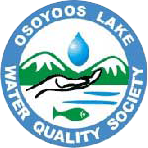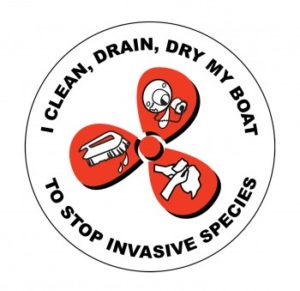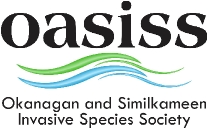Frequently Asked Questions
What factors challenge the health of Osoyoos Lake?

Waterfowl in the wetlands of Osoyoos Lake. Photo Credit: Neil Bousquet
An increase in human population, leading to:
- increased demand for irrigation, drinking and domestic water;
- loss of natural lakeshore and fish habitat;
- loss of wetlands;
- increase in algae, and aquatic weeds such as Eurasian Milfoil;
- pollution coming from motorboats, agricultural runoff, septic tanks, urban runoff, storm drains, lakeside development, bird excrement, and general litter/garbage and airborne pollutants
Is the lake safe for swimming?
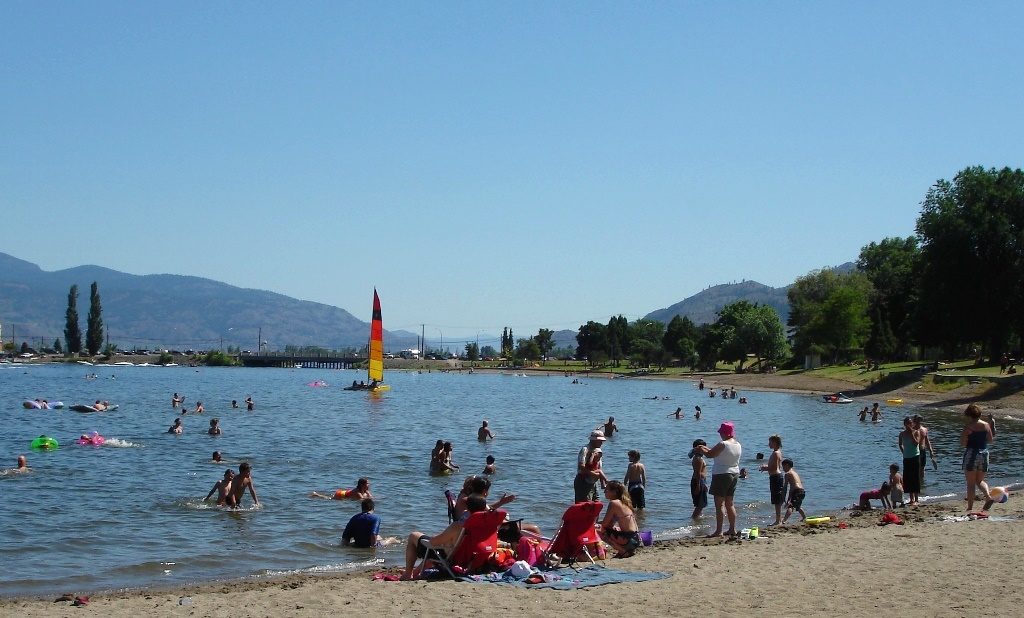
Beach adjacent downtown Osoyoos. Photo Credit: Alicia Osland
Yes, it is , however we recommend that people, and particularly small children, stay away from shallow areas where geese congregate, as geese droppings carry bacteria such as E. coli.
SAFETY ALERT!
Swimmers should also be cautious of the deep water and strong currents on the south side of the Haynes Point sand spit.
CAUTION: Swimmers should never attempt to swim across the boat channel at the tip of Haynes Point. Many have drowned trying.
How deep is Osoyoos Lake?
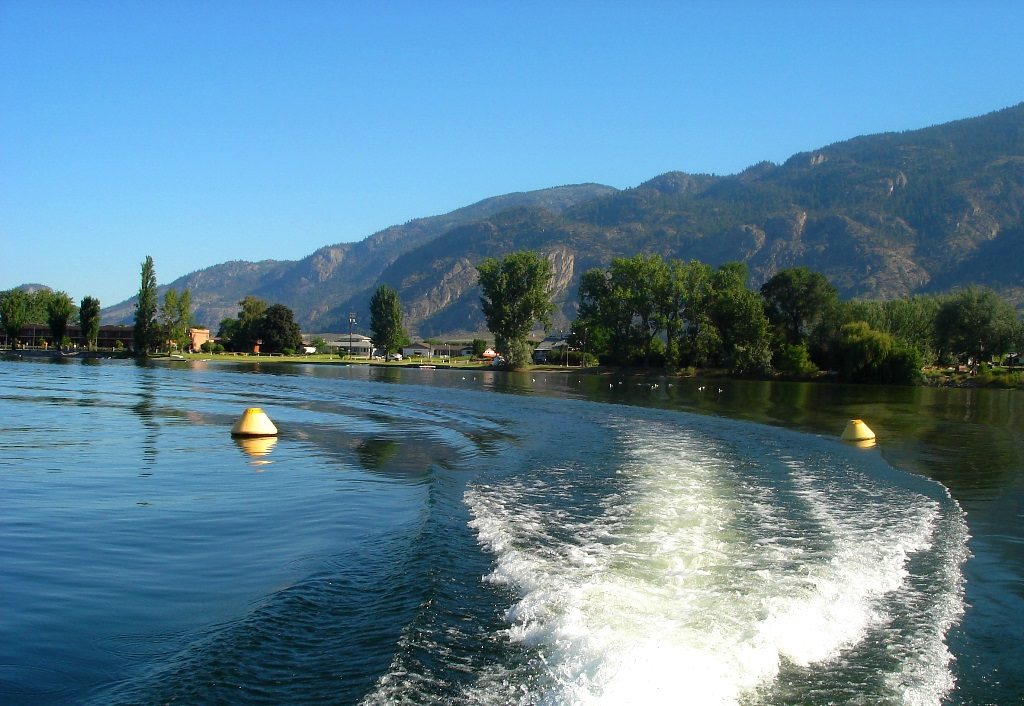
To assist watercraft to navigate through a narrow area of the lake, a deep channel has been dug between the two buoys east of Haynes Point. One should not attempt to paddle or swim across this section of the lake. Photo Credit: Alicia Osland
The lake’s deepest point is near the centre of the north basin east of the fruit packing and storage facility on the west shore. Here the lake drops to a depth of 64 metres (208 feet). The average mid-lake depth across the lake is approximately 14 metres.
Boaters should avoid the long sandspit at the east end of Haynes Point Provincial Park, where the water is usually less than knee deep. Watch for markers alerting to the shallow water.
Can I fish the lake and eat my catch?
Yes you can fish and eat your catch. However, you need to abide by fishing regulations which are available at several locations in the town of Osoyoos. A good place to start is the Osoyoos visitor information centre next to the Husky station on highway 97. Good places to fish are near the bridge crossing the lake along ‘motel row’ and adjacent to the entrance to Solana Bay. (Read More On Fishing)
What types of fish are in the lake?
There are about 11 main species of fish found in Oaoyoos Lake. These include: Rainbow Trout, Small& Large Mouth Bass, Black Bullhead, Yellow Perch, Carp, Large-scale Suckers, Whitefish, Sockeye & Kokanee Salmon and Black Crappie.
What do the painted yellow fish next to the storm drains mean?

An initiative of the OLWQS, these painted symbols are to remind people not to dump litter, oils or anything potentially toxic to fish down storm drains. Photo Credit: Alicia Osland
An initiative of the OLWQS, these painted symbols are to remind people not to dump litter, oils or anything potentially toxic to fish down storm drains. The drains exit directly from the street directly into Osoyoos Lake without filtration or treatment of any kind. Storm drains can contribute to the pollution of Osoyoos Lake. (Read More about Storm Drains)
What is swimmer’s itch?
Itchy red spots may occur on your skin after swimming. The spots may last several days. They are caused by a parasite called schistosomes that live in tiny snails and aquatic birds during two stages of their life cycle. It can be prevented by showering or towelling off thoroughly after swimming, and by staying away from the shallow areas of the lake where geese, ducks and other waterfowl congregate. It can be treated with 1% hydrocortisone cream. Swimmer’s itch rarely occurs and should not be a deterrent to enjoying swimming in Osoyoos Lake (Read More about Swimmer’s Itch)
What About Boating?

Watercraft regulations have changed over the years. Today, everyone born after 1983 to obtain a Pleasure Boat Operator’s Card provided by Boatsmart Canada ($50 single). You can obtain this online at the above link, at the Starlite Marina (Holiday Inn) near Osoyoos bridge or at a Canadian Tire store. You will be given a manual to study and then asked to later take a written test. You will then be issued a temporary licence with the official certificate being mailed to you within 6 weeks. Marina staff have a zero-tolerance policy regarding safety and environmental protection, and give all boat/seadoo renters a 20-minute orientation session before allowing people on the water.
The ‘Safe Boating Guide’ can be studied online or obtained from the Department of Fisheries and Oceans, and from the Starlite Marina.
Large motor boats and seadoos can cause serious erosion, pollution, noise and safety problems in the lake, so we strongly encourage the use of non-motorised boats such as sailboats and canoes.
Can I Cross the US Border in a Boat?
You are advised NOT to cross the border, even if you don’t intend to go ashore. If you do cross, you have to get out of your boat at Oroville State Park and phone US Customs. You will need all the documentation you’d normally need if you were crossing in a vehicle, plus a special permit obtained in advance from Customs. A Customs officer will come to your boat and inspect it before allowing you to proceed. You must also phone and then wait for Canadian Customs at the Starlite Marina dock when you return. (So you see it can get quite complicated!) (Read More on Boating)
Frequently Asked Questions
What factors challenge the health of Osoyoos Lake?

Waterfowl in the wetlands of Osoyoos Lake. Photo Credit: Neil Bousquet
An increase in human population, leading to:
- increased demand for irrigation, drinking and domestic water;
- loss of natural lakeshore and fish habitat;
- loss of wetlands;
- increase in algae, and aquatic weeds such as Eurasian Milfoil;
- pollution coming from motorboats, agricultural runoff, septic tanks, urban runoff, storm drains, lakeside development, bird excrement, and general litter/garbage and airborne pollutants
Is the lake safe for swimming?

Beach adjacent downtown Osoyoos. Photo Credit: Alicia Osland
Yes, it is , however we recommend that people, and particularly small children, stay away from shallow areas where geese congregate, as geese droppings carry bacteria such as E. coli.
SAFETY ALERT!
Swimmers should also be cautious of the deep water and strong currents on the south side of the Haynes Point sand spit.
CAUTION: Swimmers should never attempt to swim across the boat channel at the tip of Haynes Point. Many have drowned trying.
How deep is Osoyoos Lake?

To assist watercraft to navigate through a narrow area of the lake, a deep channel has been dug between the two buoys east of Haynes Point. One should not attempt to paddle or swim across this section of the lake. Photo Credit: Alicia Osland
The lake’s deepest point is near the centre of the north basin east of the fruit packing and storage facility on the west shore. Here the lake drops to a depth of 64 metres (208 feet). The average mid-lake depth across the lake is approximately 14 metres.
Boaters should avoid the long sandspit at the east end of Haynes Point Provincial Park, where the water is usually less than knee deep. Watch for markers alerting to the shallow water.
Can I fish the lake and eat my catch?
Yes you can fish and eat your catch. However, you need to abide by fishing regulations which are available at several locations in the town of Osoyoos. A good place to start is the Osoyoos visitor information centre next to the Husky station on highway 97. Good places to fish are near the bridge crossing the lake along ‘motel row’ and adjacent to the entrance to Solana Bay. (Read More On Fishing)
What types of fish are in the lake?
There are about 11 main species of fish found in Oaoyoos Lake. These include: Rainbow Trout, Small& Large Mouth Bass, Black Bullhead, Yellow Perch, Carp, Large-scale Suckers, Whitefish, Sockeye & Kokanee Salmon and Black Crappie.
What do the painted yellow fish next to the storm drains mean?

An initiative of the OLWQS, these painted symbols are to remind people not to dump litter, oils or anything potentially toxic to fish down storm drains. Photo Credit: Alicia Osland
An initiative of the OLWQS, these painted symbols are to remind people not to dump litter, oils or anything potentially toxic to fish down storm drains. The drains exit directly from the street directly into Osoyoos Lake without filtration or treatment of any kind. Storm drains can contribute to the pollution of Osoyoos Lake. (Read More about Storm Drains)
What is swimmer’s itch?
Itchy red spots may occur on your skin after swimming. The spots may last several days. They are caused by a parasite called schistosomes that live in tiny snails and aquatic birds during two stages of their life cycle. It can be prevented by showering or towelling off thoroughly after swimming, and by staying away from the shallow areas of the lake where geese, ducks and other waterfowl congregate. It can be treated with 1% hydrocortisone cream. Swimmer’s itch rarely occurs and should not be a deterrent to enjoying swimming in Osoyoos Lake (Read More about Swimmer’s Itch)
What About Boating?

Watercraft regulations have changed over the years. Today, everyone born after 1983 to obtain a Pleasure Boat Operator’s Card provided by Boatsmart Canada ($50 single). You can obtain this online at the above link, at the Starlite Marina (Holiday Inn) near Osoyoos bridge or at a Canadian Tire store. You will be given a manual to study and then asked to later take a written test. You will then be issued a temporary licence with the official certificate being mailed to you within 6 weeks. Marina staff have a zero-tolerance policy regarding safety and environmental protection, and give all boat/seadoo renters a 20-minute orientation session before allowing people on the water.
The ‘Safe Boating Guide’ can be studied online or obtained from the Department of Fisheries and Oceans, and from the Starlite Marina.
Large motor boats and seadoos can cause serious erosion, pollution, noise and safety problems in the lake, so we strongly encourage the use of non-motorised boats such as sailboats and canoes.
Can I Cross the US Border in a Boat?
You are advised NOT to cross the border, even if you don’t intend to go ashore. If you do cross, you have to get out of your boat at Oroville State Park and phone US Customs. You will need all the documentation you’d normally need if you were crossing in a vehicle, plus a special permit obtained in advance from Customs. A Customs officer will come to your boat and inspect it before allowing you to proceed. You must also phone and then wait for Canadian Customs at the Starlite Marina dock when you return. (So you see it can get quite complicated!) (Read More on Boating)
